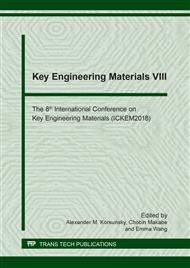p.342
p.350
p.359
p.365
p.371
p.376
p.383
p.390
p.395
Removal of Heavy Polynuclear Aromatics by Activated Carbons
Abstract:
Heavy polynuclear aromatics (HPNA) is a complex molecules generated during hydrocracking process in waxy oil. HPNA is eliminated by a commercial activated carbon in the absorber to prevent the fouling in the pipelines and the decrease of product yield. In this work, the commercial activated carbons containing the different micropores and the different mesopores were selected to investigate the influence of pore structure on the HPNA removal. Here, the surface area of commercial activated carbons were quite equivalent. The results show that the activated carbon possessing the high mesopores can adsorb HPNA better than the activated carbon having the high micropores in spite of the summation of a micropore volume and a mesopore volume are quite equal. Therefore, the mesopore structure is a major role in the HPNA removal.
Info:
Periodical:
Pages:
371-375
Citation:
Online since:
August 2018
Authors:
Price:
Сopyright:
© 2018 Trans Tech Publications Ltd. All Rights Reserved
Share:
Citation:


